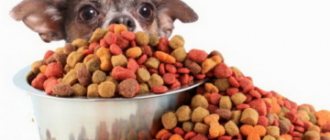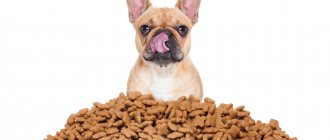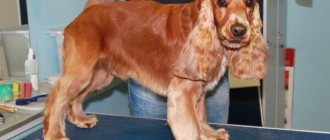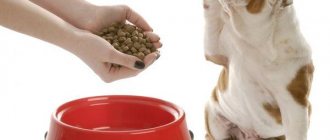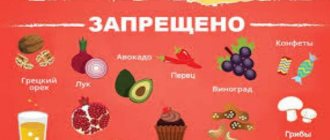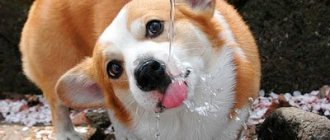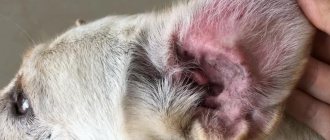Cocker spaniels are favorites of children and adults, captivating with their cheerful disposition and sweetest face. These are lovers of active games and delicious food. Moreover, they are absolutely indiscriminate in food: the cocker will eat everything edible and inedible that it finds. This breed is prone to obesity. Cocker spaniels quickly get fat, and an overfed pet is a lethargic, sick dog with an unwillingness to play and communicate with the owner. How to create the correct diet for a pet from puppyhood and what to feed a spaniel is discussed in this article.
What to feed your spaniel?
Types of feedings
First you need to understand the types of feeding for small cockers. The breed responds positively to all three standard feeding methods:
- ready-made dry mixtures;
- natural products;
- mixed type: dry food is supplemented with wet food, meat, cereals.
When preparing a diet, it is important to take into account the dog’s temperament.
There are adherents of each type of food; it all depends on the choice of the owner. However, the fundamental factor when choosing the type of feeding should be the character of the animal and the purposes for which the owner got the pet. For example:
- Sports dogs that are trained to participate in hunting, fishing, hiking, and sports should choose dry food. It must be of high quality. Such foods contain a lot of protein for muscle development, support of ligaments and the skeletal system, as well as carbohydrates, which provide energy. In addition, it is convenient to take dry food with you to feed your pet during training or fishing.
- “Sofa” pets can be given natural products - meat, soups, cereals. However, a veterinarian’s consultation is necessary here: perhaps the individual needs of the pet’s body require a more competently selected menu.
- It is recommended to give puppies natural foods. During growth, their digestive system must become stronger and learn to process hard fibers, and their teeth are renewed from careful chewing before switching to dry food.
Many spaniel owners opt for dry food
As a rule, most dog breeders choose convenient feeding with dry food. They are trying to get away from the mixed type for several reasons: it is uneconomical and problems arise in creating a complete diet. In addition, the dog’s body may not accept mixed food - to digest dry and natural food, different enzymes and absorption periods are needed.
Organization of feeding area
Before you feed your American Cocker Spaniel, you need to organize a place for food. The dog should eat in a specially designated, clean area. For natural food, two bowls are useful - for liquid and solid food. For dry food, one is enough. There should always be drinking water here. You must strictly follow your diet.
READ How to castrate a cat at home
During the feeding period, it is better to fasten the hanging ears of a spaniel from behind with an elastic band so that they do not get into the food. The bowl should be on a raised surface. As the puppy grows, the stand should also become higher so that the dish is always at the level of the dog's chest. Before serving, food should be heated to a temperature of 36-40°C.
The owner will be perplexed as to what to feed his cocker spaniel if he has not been taught the correct diet since childhood. The dog will refuse healthy food. An adult dog willingly eats only the food to which it has become accustomed since infancy.
What to feed a Cocker Spaniel puppy?
The diet of a small cocker must certainly include:
- Meat is the foundation of any dog menu, including cockers. Beef or chicken is preferred; non-dietary pork and lamb should not be given. The meat must be pre-boiled, without bones. Puppies need enough volume at the rate of 50 grams per 1 kilogram of weight. Please note: the cocker's stomach is not capable of digesting minced meat.
- Offal . They can replace one “meat” day a week. The heart, liver, and lungs are thoroughly boiled before serving, and the serving size is increased by 1/3 compared to meat. But at an early age (up to 3 months), it is not advisable to give offal to puppies.
- Fish. Occasionally, you can pamper your pet with sea fish. This should be a boiled fillet without a single bone. You can give it no more than three times a week, and seafood and river fish are contraindicated for cockers.
Proper nutrition is the key to a healthy puppy life
- Dairy . The diet of a small and even an adult cocker should definitely include kefir, cottage cheese, yogurt, and cheeses. They help your pet's digestive system work properly. It should be remembered that any intake of “milk” is food. There is no need to replace milk with water or give it between meals. A puppy should be accustomed to such products from infancy, so that in adulthood he does not suffer from diarrhea from whole milk. Also, up to 10 months, the baby needs calcined cottage cheese: ground eggshells are added to the regular product.
- Bread and cereals . These products are designed to diversify your pet’s menu; you should not make them the basis. Porridges are cooked in milk or water; you can add vegetables or butter. Preference is given to buckwheat, rice and oatmeal.
- Eggs . Necessary, but in small quantities. It is preferable to give a soft-boiled egg or runny omelet no more than once or twice a week.
- Fruits and vegetables . Plant fiber is necessary for a maturing body. You can get it from turnips, zucchini, pumpkin, carrots, and cucumbers. It is preferable to feed it unprocessed, seasoned with sour cream or butter, you can add torn greens to the “salad”. Some fruits are allowed: apple, melon, pear, watermelon, as well as berries - raspberries, garden strawberries and pitted cherries. Fruits are rarely given as a delicacy, as they contain a lot of sugar.
- Parsley, onion and garlic feathers, dill . Chopped fresh greens are an excellent vitamin supplement to your pet’s main food.
- Crackers and dried fruits . They are also occasionally used as a treat to diversify the diet.
- Coal or chalk . Required for children during the period of active development. A plate with pieces of chalk can be placed in a convenient place so that the puppy can chew on it whenever he wants.
When creating the menu, the individual characteristics of the dog’s body are taken into account.
From the age of two months, you should give your baby vitamins for puppies, as well as dried seaweed. They will become a source of natural iodine and other minerals necessary for proper development. And from 3 to 7 months the puppy begins to change teeth: during this period you need to give him 2-3 tablets of calcium gluconate daily. If he does not want to eat the tablets, you need to crush them and sprinkle them into food.
Important! To prevent parasites, you should give your cocker finely chopped garlic. It is recommended to spread it along with butter on a small piece of bread or put it in food. You should not give more than one garlic clove per week.
How many times a day should you feed your cocker spaniel?
Cockers are very voracious, so owners need to carefully monitor portion sizes and feeding frequency. A pet that has just arrived in the family (usually puppies are bought at one and a half months of age) should be given no more than 4-5 tablespoons of food per meal. As the dog grows, the volume of food increases to 1.5-2 glasses.
Cocker Spaniels are big snack eaters.
Taking into account age-related changes, the number of feedings per day looks like this:
- up to two months the pet eats 5-6 times daily;
- from two to four months, puppies are suitable for four meals a day;
- from four to six months – meals 3-4 times a day;
- from six months to a year - a gradual transition to two meals a day, but it is acceptable to feed three times a day;
- from one year onwards – switch to eating 1-2 times a day.
Diet is as important as the amount of food you eat
Some experts recommend single meals as the most appropriate for mature cocker spaniels. The owner chooses the meal time that is most convenient for himself, since the most important thing for the dog is to receive food every day at the same hours.
Important! If your pet’s weight begins to exceed the established norm, you need to give him one fasting day a week.
How and what to feed a small English cocker?
The owner needs to monitor the puppy’s behavior during and after meals in order to make feeding the most harmonious. The possible behavior of your pet can be checked against the table.
Table 1. Variants of cocker behavior and its reaction to food
| 1st type | 2nd type | 3rd type | |
| How he eats | He eats the entire portion greedily, “chasing” the empty bowl, licking it. | He ate slowly, and after some time he went back to the bowl for food. | The abdomen becomes very bloated after eating. |
| Cause | Not enough food was provided or the interval between feedings was too long. | Too much food at one time or more often than required. | The puppy is overeating, you need to reduce the portion. |
The dog should always have access to fresh water
It is best to purchase a low feeding stand for your puppy that can be adjusted and grows with your baby. The dog needs to reach for the bowl, not lean towards it. And with a plate on a stand, the long ears of cocker spaniels will not get into the food, but will hang over the edges. The ideal option would be a bowl that is narrow at the top with an extension downwards, mounted on an iron hoop with legs.
Properly selected tableware is an important part of food culture
The puppy needs to buy two smooth bowls - for food and water, so that he does not get hurt by licking them. There should always be water in the plate, and food only during meals. The food that the puppy has not eaten is transferred to a container and sent to the refrigerator until another meal. Before serving, the food must be heated to approximately 40 degrees.
Diet
It is important to follow the cocker's feeding schedule. The pet must eat at strictly designated hours; no treats should be allowed between feedings. Otherwise, the slender toy will grow into a beggar, fat and with poor health.
You can't follow the lead of a spaniel begging for a treat.
If the puppy refuses the prepared food, there is no need to replace it with another. It’s worth removing it and giving it to your pet next time. Otherwise, the puppy will quickly realize that if he “shows off”, they will immediately bring him something tasty. It is forbidden to force the dog to eat the entire portion if he does not want to. Cockers occasionally create fasting days, following instinct.
The digestive tract and glands involved in digesting food quickly adapt to the established regime and type of food. Therefore, a sudden change in the type of food or meal time leads to digestive disorders.
A sudden change in diet will not have the best effect on digestion
Important tips for feeding your puppy:
- For several days (4-5) after the puppy appears in the house, you need to feed it only with foods that it is accustomed to. You need to ask the breeder about the feeding regime and diet and gradually add new products to the usual food.
- You cannot give your pet food from the owner’s table and adapt it to the human diet: people and animals have significantly different needs for the volume of food, its quality and quantity.
- You should feed your puppy only after going outside for a walk. The first pro: the baby will quickly understand that active games will end with a delicious lunch, and without persuasion he will rush home after the command. The second “pro”: when walking, a well-fed dog will bend its spine under the weight of a full belly; also, due to activity on a full stomach, intestinal volvulus is possible.
- You can calculate the amount of food that is enough for a pet per day using a simple arithmetic operation: up to 6 months - 6-7% of body weight, over six months - 3-4%.
The dog should be able to eat comfortably
A small cocker spaniel should have its own dining area. You need to allocate a small area for him where he will not be disturbed by household appliances or furniture. This should be a dry, clean and regularly ventilated place. For food to be digested properly, your pet should eat slowly and in a quiet environment.
Table 2. Approximate daily menu for puppies of different ages
| 1-2 months | 3-4 months | 5-8 months | 9-11 months | |
| Puppy weight, normal | 3-4 kg. | 5-8 kg. | 8-12 kg. | 12-14 kg. |
| Total food volume | 0.2-0.4 l. | 0.5-0.7 l. | 0.7-1 l. | 1.5 l. |
| Number of feedings, interval | 6 times a day, every 3 hours | 5 times, 3-4 hours | 4 times, 5 hours | 3 times, every 6-7 hours |
| Sample menu | 07:00 – cottage cheese with eggshells/yogurt/natural yogurt; 10:00 – finely chopped cubes of raw meat + boiled carrots; 13:00 – a little milk + egg; 16:00 – buckwheat with rice + stewed meat/fish; 19:00 – cheese/curd mixture with eggshells; 22:00 – fresh meat/scalded with boiling water with boiled carrots and butter. | 08:00 – kefir/ryazhenka; 11:00 – cottage cheese/yogurt + greens; 14:00 – oatmeal + sea meat/fish; 18:00 – raw vegetables + curd mass; 22:00 – porridge + fish/meat. | 08:00 – cottage cheese or kefir with raw egg; 13:00 – fresh/stewed meat + buckwheat or rice/fresh vegetables with butter; 17:00 – curd mass/boiled offal + buckwheat with rice; 22:00 – raw meat + stewed vegetables/porridge | 08:00 – kefir/porridge with herbs; 15:00 – oatmeal porridge + boiled fish/offal; 22:00 – fresh/boiled vegetables with butter + cottage cheese. |
Cocker Spaniels love variety in their food.
Experts recommend preparing vegetable salads more often with the addition of protein products - eggs, fish, meat. You need to add vegetable oil to vegetables so that they are better absorbed. Cockers accept this dish with appetite if they have been accustomed to vegetables since infancy. These are just approximate diets that the dog owner can change at his own discretion. The main thing is to choose those products that will bring the greatest benefit to the baby and will contain all the required microelements. This also applies to industrial feed. In the first year of life, it should be included in the puppy’s diet.
Premium dry food for puppies contains all the necessary elements
Types of food for spaniels
Before you understand the basic principles and rules of dog nutrition, you should understand the types of food:
- Dry food.
- Natural food.
- Mixed feed.
Absolutely any type of food listed is suitable for the Cocker Spaniel breed. What food should I feed my spaniel? Only the owner himself decides what food to choose for his pet.
Natural food, of course, is more balanced and beneficial for the dog, but industrial food costs owners much less, and besides, it’s also convenient; you don’t have to rack your brain every time about what to prepare for your pet.
There is also a mixed method of feeding dogs. It consists of adding natural products to dry food.
In all cases, it is necessary to remember that food must be of high quality and fresh, and not all foods that are healthy for humans are suitable for feeding a dog.
The nutrition of the English and American cocker should depend on the following parameters:
- Dog size. When setting the size of the food portion, you should take into account the height and weight of the pet. An English Cocker that eats too much will soon become fat and clumsy. A small portion of food will cause a constant feeling of hunger, which is very unhealthy for the puppy’s growing body.
- Age. When preparing a diet, the age of the cocker is very important. It is recommended to feed your Cocker Spaniel puppy a balanced diet. Up to a year, internal organs and bone apparatus are actively developing. The food must contain a sufficient amount of proteins as well as nutrients. Feeding frequency – 5-6 times a day. Adult cockers eat less often - 1-2 times a day.
- Physical activity. Active, mobile dogs that walk a lot and participate in competitions need high-calorie food that will replenish all energy costs. Older dogs with reduced physical activity should eat dietary food.
- Health status. Any illness, rehabilitation period, pregnancy, require adjustments to the diet. Depending on the pathology, one or another diet is prescribed. During pregnancy, enhanced nutrition is offered. During the recovery period, vitamin preparations are added to the main diet. The introduction of a new type of food begins with testing it, identifying the risk of developing an allergic reaction.
Feeding the puppies
An English and American cocker puppy begins to feed at the age of 4-6 weeks. Weaning from the mother's breast occurs no earlier than the baby learns to eat adult food.
To begin with, give soaked dry food. One serving is 3-4 tablespoons. Gradually the amount of solid food in the feed should increase.
A one-month-old puppy is introduced to meat, fish, vegetables, and cottage cheese. At 1 month he is fed 5-6 times a day, at two months - 4 times.
The number of feedings should decrease with age. At 8 months, a Cocker Spaniel puppy is given food 2 times a day, and when it reaches a year, it is transferred to a single meal.
An older puppy should be fed based on its weight. The formula for calculating the size of one portion of food is simple. Before six months, 6-7 percent of body weight, and after six months – 3-4 percent.
A Cocker Spaniel puppy must be given specialized food for young animals for up to one year. It is recommended to follow the feeding conditions, which can be read on the packaging.
You should feed your cocker spaniel at the same time, avoiding intermediate snacks and treats with “sweets” from the table.
If you feed your English Cocker puppy after a walk, he will happily rush home, knowing that he will receive a delicious lunch.
What to feed an English Cocker Spaniel after he is one year old is up to the owner himself. At this age, the pet is transferred to two or one meal a day. The daily portion of an adult dog can be 1.5-2 liters. The dog must always have access to water, regardless of the type of food.
The health of a pet depends on whether its food contains enough nutrients, vitamins and microelements. When choosing a diet for an adult cocker spaniel, you should be guided by the following rules:
- The volume of protein food should decrease slightly and amount to 20-30 g per kilogram of weight, since the active growth of the body has already completed.
- The average volume of food eaten should be approximately 50 grams per kilogram of body weight. A dog leading an active lifestyle needs more food.
- Milk and dairy products are not beneficial for an adult dog. You can replace them with low-fat kefir and cottage cheese.
- If the dog is overweight, then the size of the food portion should be reduced to eliminate the risk of developing obesity.
Before you feed your American Cocker Spaniel, you need to organize a place for food. The dog should eat in a specially designated, clean area. For natural food, two bowls are useful - for liquid and solid food. For dry food, one is enough. There should always be drinking water here. You must strictly follow your diet.
We suggest you read: What does a horse eat - types of feed, dietary tips
During the feeding period, it is better to fasten the hanging ears of a spaniel from behind with an elastic band so that they do not get into the food. The bowl should be on a raised surface. As the puppy grows, the stand should also become higher so that the dish is always at the level of the dog's chest. Before serving, food should be heated to a temperature of 36-40°C.
The owner will be perplexed as to what to feed his cocker spaniel if he has not been taught the correct diet since childhood. The dog will refuse healthy food. An adult dog willingly eats only the food to which it has become accustomed since infancy.
dd dog food - veterinarian reviews, composition overview and recommended price
Proplan food for dogs - composition of the manufacturer's food, reviews from veterinarians and dog owners (75 photos and videos)- Dilly dog food - price, reviews, composition and use in the diet (110 photos)
Help the project, repost
It is important to decide what is more convenient for you and better for your dog: dry food or natural food. Each type of feeding has its pros and cons.
High quality dry food (premium and super premium) is already balanced, and you don’t need to think about creating a diet. It is convenient to store and take on the go. When choosing dry food, you need to take into account the dog's age, activity level and body condition.
However, dogs often eat natural food more readily. But at the same time, you need to spend time preparing food and creating a diet so that it is balanced and complete, and this is not easy.
One thing you should definitely not do is feed your English Cocker Spaniel food from your table. The digestive systems of humans and dogs function differently, and the needs for quality, quantity and types of food are very different.
English Cocker Spaniels are prone to allergies, so each new ingredient is introduced gradually, and you need to carefully monitor for signs of allergies: itching, redness of the skin, watery eyes, hair loss, etc. If you notice any of the above, contact your veterinarian as soon as possible.
English Cocker Spaniels have an enviable appetite and love to beg. You will need incredible strength to resist the pleading gaze of an eternally hungry pet - and yet you will have to show it. Otherwise, the dog will quickly gain extra pounds, and this is harmful to health.
This breed does not have any special feeding requirements. Having considered all the pros and cons, you can find the most acceptable one for a particular owner and depending on the situation. The main thing is that it should be:
- useful for four animals;
- did not greatly burden the owner;
- did not cross the line of common sense.
Granules from a bag are becoming more and more common, and this is understandable. The manufacturer is trying in every possible way to “persuade” the owner that the food has the highest performance, and his puppy will not grow up without granules. Meanwhile, independent laboratory testing constantly proves that the feed does not have the properties and composition specified in the recipe and annotation.
The puppy eats the granules with pleasure. However, the number of flavors and flavoring additives is so great that it cannot be otherwise.
Ready-made food is easy to use. By purchasing a large bag with a long shelf life, you can feed your puppy without any problems. There is no need to even wash dishes. Only the question of the dog's health remains open.
Ready-made foods are derivatives with the addition of artificial protein. High temperatures in the extruder kill all biologically active substances and vitamins. When feeding ready-made food, you need to be careful about the puppy’s water balance. The manufacturer warns on the package that there must be water in the drinking bowl at all times, since the feed causes thirst.
Advantages
The food has a number of advantages:
- with its help you can feed the puppy quickly;
- clean dishes will remain after the meal;
- feed is easy to buy and store.
Flaws
When feeding with prepared foods:
- inability to control the composition independently;
- in a coma there may be allergens that are difficult to identify;
- non-compliance of the formulation with the results of laboratory tests (even for expensive samples) casts doubt on its usefulness.
If these arguments are not arguments, then when choosing food you should at least ask:
- labeling (manufacturer, address, telephone);
- date of manufacture;
- deadline for implementation;
- read the manufacturer's recommendations.
Mixed diet
This is the type of feeding that many owners prefer. Feeding with natural food is constant, and in times of need they are fed with ready-made food. Ready-made food is used for:
- travel;
- inability to purchase food;
- Difficulties with preparing food.
Whatever diet the owner chooses, it is necessary to monitor the state of the gastrointestinal tract. At the slightest “failures,” you should reconsider the feeding program and seek help from a specialist.
What should you not feed English Cocker Spaniels?
Some foods that are not intended for a dog's stomach can cause body disorders and even death of the pet. Therefore, you need to make sure that you don’t get into the cocker’s mouth:
- Corn, beans, pasta, potatoes, wheat bread. The cocker's stomach is unable to digest these foods; they contribute to indigestion.
- Spices and seasonings, especially hot ones. Since a dog’s sense of smell is hundreds of times sharper than a human’s, what is a pleasant tang for the owner can cause a loss of smell in the pet.
- Pork, fatty lamb, raw chicken.
- Barley and millet porridge.
The dog should eat only healthy foods recommended by experts.
Your pet should not be fed very cold or very hot food; food should be at room temperature or slightly warmer (about 40 degrees). All fatty, spicy, smoked, sweet and salty foods are prohibited.
Strictly prohibited products
- river and thermally untreated sea fish (leads to infection with worms);
- seafood;
- tubular bones and ribs (split into long sharp particles that can leave cuts in the gastrointestinal tract and lead to the death of the dog);
- sugar, chocolates, pastries, cakes (reduce appetite and spoil digestion, destroy teeth, cause tearing);
- sausages, sausages (severely damage the liver, the animal can die in adolescence);
- broccoli or uncooked white cabbage;
- spoiled and rotten foods (lead to indigestion).
Poor nutrition leads to undesirable consequences
Feeding cocker spaniels: important nuances
To ensure that food does not harm your pet, it does not overeat and does not remain hungry, it is important to take into account the following nuances:
- Dog sizes. Spaniels can vary greatly in size: for example, the English cocker is slightly larger than the American one. Big dogs need more food.
- Age. Small cockers need a lot of nutritious food during their growth period. Puppies are allowed plenty of food, the main thing is that the food is “correct”. Older cockers run and jump much less, so there should be fewer calories in their diet.
- Pet's character. The majority of cockers are active runners who can organize a playground even in a small apartment. Despite this, there are also lazy individuals. For such not particularly active pets, the portion can be safely reduced by 25%.
Excess feed is unacceptable, veterinarians remind
- Load level. For dogs that perform hunting duties, go fishing and hiking with their owner, the diet should be nutritious and high in calories. In apartment dogs, too nutritious food will cause obesity, since there is nowhere to spend calories.
- Pet's condition. During the postoperative period, recovery from illness, bearing and feeding babies, the dog needs more protein foods and foods rich in microelements.
- Allergic reactions. Some cockers (especially decorative ones) are prone to allergic reactions. When introducing a new product into the diet, it needs to be tested by giving a small portion first. If a negative reaction occurs - your eyes become watery, itching, irritation begins - you should abstain from the product.
New products should be introduced into the menu gradually
After the puppy has eaten a small amount of a new product, 12 hours should pass. If after this time there is no negative reaction, you can introduce a new product to the menu.
Video - Proper feeding and endurance training in a cocker spaniel
What to feed a spaniel during pregnancy and after birth?
Proper feeding during pregnancy will allow the dog to bear healthy puppies and quickly recover after giving birth.
During the first 5 weeks after conception, while the embryos are still very small, the Russian Spaniel’s diet is not changed. From week 6, the serving size is increased by 10% every 7 days. By the time the puppies are born, the dog is fed one and a half rations of food.
From about 5 weeks, the protein level in the diet increases. The Russian spaniel is fed 3 times a day in small portions, which is due to the pressure the puppies put on the stomach and other organs. By day 44, the number of meals reaches five.
It is important to note that the dog should not overeat. Excess weight is fraught with deterioration in health and complications during childbirth.
With natural feeding, the dog is given vitamins for pregnant women:
If a Russian Spaniel is fed dry food, they buy products from the lines for pregnant women. It is impossible to change your diet suddenly while carrying puppies - this is a serious stress for the body. It is also not recommended to buy other brands of food.
For 2-3 days after birth, Russian Spaniel puppies are fed 3 times a day:
The meat is introduced gradually in small portions.
By the end of the first week, food is given 4 times a day. There should always be clean water nearby, because it enhances lactation.
The daily amount of food depends on the number of puppies. If there are 4 babies in the litter, feed is given 1.5 times more than usual, if there are 6 – 2 times more.
After the puppies start feeding the puppies, the portions for the mother are gradually reduced. When all the babies are taken away, the Russian spaniel is given a fasting day - they are fed only ¼ of the norm.
Over the next 3-4 days, the amount of food is gradually increased and brought to the usual volumes.
Features of caring for an English Cocker Spaniel
The Cocker Spaniel is an infinitely beautiful and graceful breed. The main pride of pets is their long, shiny coat with small curls. And for the owner, it is the most obvious drawback of the dog, because the coat of active toy spaniels requires special care. If you don't take care of the coat enough, the dog will lose all its beauty and presentable appearance.
A well-groomed cocker spaniel is a true eye magnet.
Care Tips:
- Spaniels (unlike dogs of other breeds) shed constantly. Pets' fur needs to be combed daily and dead hairs removed to prevent tangles from forming. It is also important to trim the coat occasionally.
- The dog is brushed regularly with a special brush with teeth of different lengths. The procedure will remove sticks tangled in the fur, and also produces a massage effect that is useful and pleasant for your pet. At the same time, bathing should not be overused, as water procedures will make the coat dull and contribute to the formation of dandruff.
- After every winter or spring walk, your pet’s paws should be inspected and the reagent removed from them. Otherwise, the development of inflammation is possible.
- Cocker spaniels also need to have their eyes washed regularly as they are prone to dirt and tearing. The procedure is carried out three times a week using weak brewed dark tea or liquid purchased at a veterinary pharmacy.
It is necessary to constantly monitor the cleanliness of cocker eyes.
English Cocker Spaniels have fairly good health and can live up to 12-15 years. However, eye diseases are common in animals of this breed; they may develop cataracts or glaucoma.
Important! The pet must be adapted to hygiene procedures from puppyhood. Over time, they will get used to it, and each procedure will become automatic.
Ear washing
The long ears of Cocker Spaniels require close and constant attention. When eating, they need to be tied up to prevent food from getting in there, or you need to buy a special, comfortable bowl for your pet.
After a daily walk, the outer and inner surfaces of the auricle are carefully examined. If the ears become dirty, they need to be cleaned with a special solution that can be purchased at a veterinary pharmacy. You also need to check if there are mites or inflammations in the ear; if there are, see a veterinarian.
Cocker Spaniel ears are the hallmark of the breed.
Ear discharge that may appear in cockers can be easily removed with a cotton pad. If there are excess hairs in the ear, it is recommended to remove them.
Important! The first sign that your pet has ear problems is shaking its head and constantly scratching its ears. You urgently need to examine your pet; if there are no visual changes, make an appointment with a veterinarian.
Nail trimming
A necessary procedure that cockers need to be taught to do from childhood is trimming their nails. It has the following algorithm:
- Buying a hair clipper. A sharp veterinary pruner will do.
- Inspection of claws. It is necessary to find the pulp where the blood vessels are concentrated so as not to accidentally damage it.
- A haircut. You need to cut about 2 mm from the tip of the claw at an acute angle.
Nail trimming should be done carefully and confidently
Only dogs that do not wear them down while walking need to have their nails trimmed. Spaniels who walk on asphalt surfaces do not need this - their nails are constantly being sharpened. But those who like to walk in parks and squares should get used to cutting hair without waiting for strong growth and ingrown claws. You also need to remove hairs that grow between the pads on your pet's paws.
Dog pedicure
Important! If the procedure was unsuccessful, the claw was cut too short and bleeding began, it can be stopped with a special powder or veterinary pencil. As a last resort, you can stop the bleeding by dusting the wound with flour or bandaging it. If there is severe bleeding that does not stop within five minutes, you need to urgently take your pet to the veterinarian.
Oral hygiene should become a habit for your pet.
Important! To keep your cocker spaniel healthy, physical activity and long walks in the fresh air are required.
Education and training
The Russian Spaniel is considered a one-owner pet. Therefore, one person must feed, care for, walk the dog, and teach it to commands. The dog is given a short, sonorous nickname. First, after pronouncing it, a treat is given out. Gradually the puppy gets used to it and leaves everything as soon as he hears his name.
Training also includes the execution of the “Place!” command. To do this, after pronouncing the order, the puppy is lightly slapped on the croup with a hand, and then carried in his arms to the bed. Soon the dog itself runs to the mat, without waiting for physical impact. To help develop skills faster, you can reinforce them with treats and pats on the head.
READ Preparing a cat for castration. What to feed a cat during the postoperative period
The dog must be accustomed to a collar, leash and muzzle. Even if the dog never bites, he should wear a protective mask on his face when walking along city streets. To do this, all devices are put on after the command “Walk!” Gradually, the dog stops resisting, patiently endures the training and rejoices at the opportunity to frolic.
Feeding an adult spaniel
It is enough to feed an adult cocker spaniel twice a day, the total volume of food is 1.5-2 liters. Your pet should always have access to fresh water, especially if it eats dry food. If the water sits in the bowl for several days, you need to pour it out and pour a new one.
Adult dogs get energy from a varied diet
When developing a feeding plan for an adult dog, you need to adhere to the following rules:
- The volume of protein products in the food of an adult cocker is reduced to 20-30 grams per 1 kilogram of body weight. The body no longer needs a lot of material to build cells.
- The total volume of food consumed daily usually does not exceed 50-60 grams per 1 kilogram. But a lot also depends on the dog’s energy, its physical condition at the moment and the composition of the food.
- Most often, the adult cocker's body does not digest whole milk well. Instead, it is better to give kefir or yogurt.
- There is no need to give your dog fermented milk products often. Twice or three times a week will be enough.
The daily menu is planned in advance
- The main diet should consist of meat with a side dish in the form of cereals and vegetable salads. There is no need to constantly give vitamins, but in spring and autumn the dog’s body may need to be supplemented with minerals.
- The basis of the diet (2/3) should be meat - beef or chicken. It can be raw or cooked. Offal (lung, udder, liver, heart) must be thoroughly boiled before serving. It is forbidden to feed the dog only meat products - such feeding may damage the kidneys.
- As a source of animal protein, the dog is allowed eggs or cottage cheese, fish. It is also useful to give your pet cartilage; you should absolutely not give bones.
- The remaining third of the diet comes from vegetables and cereals. You can cook rice, buckwheat, oatmeal, vegetables can be fresh or stewed.
- It is useful to give fish oil to an adult cocker, starting with adding a few drops to the food and reaching up to two teaspoons per day. If you have an upset stomach, you should stop using it.
In a dog’s diet, both the quality and quantity of food are important.
The spaniel must eat the entire portion to the end. If he doesn’t leave the bowl clean, then the portion is too large and needs to be reduced urgently. A sedentary dog can be given a smaller portion - in feeding a cocker spaniel prone to obesity, the main principle is “it is better to underfeed than to overfeed.”
How to prepare food for your pet?
So, the owner who has decided to switch his dog to natural feeding should adhere to the following principles:
- You cannot fry food for feeding spaniels: they only give it boiled and stewed in water;
- meat for dogs must be fresh: chilled meat is purchased for young spaniels, adults can be frozen;
- Spaniels do not like liquid soups; they need to be given food with the consistency of porridge at room temperature;
- the simpler the better: no salt or seasonings, nothing spicy.
A dog that eats right is always full of energy
An adult spaniel needs to be fed morning and evening: at about 8 am and before bed, at 21:00-22:00. Here is an approximate menu for a cocker over 11 months old and weighing 15-17 kilograms, which can be alternated to diversify your pet’s diet.
Table 3. Daily menu options for an adult cocker spaniel
| Option 1 | Option 2 | Option 3 | Option 4 | |
| Morning | Kefir/yogurt with herbs | Fresh meat and oatmeal | Boiled fish with a side dish of vegetables | Cottage cheese and omelet or raw egg |
| Evening | Meat/offal boiled with stewed vegetables and sunflower oil | Boiled meat with fresh vegetables and sour cream | Raw meat and porridge | Oatmeal with boiled fish |
A monotonous diet will upset any cocker spaniel
Nutritional features of a pregnant dog
If your dog was overweight before pregnancy, most cereals and bread should be removed from the diet. Calories are compensated by adding greens, fresh vegetables, and cottage cheese.
- 1st month: the regimen remains the same, since the fetus is still developing very slowly. Two meals a day - morning and evening; food items should include cottage cheese, milk porridge, fresh meat, boiled liver, fresh herbs, chopped vegetables.
- 1.5 months: cottage cheese with crushed egg shells or 1 tablespoon of calcium chloride in milk per day is added to the food.
- 2nd month: the number of meals increases to three times. The daily norm certainly includes sea fish, cottage cheese and meat products. Tendons, cartilage, wings and heads of chickens, breast bones are added - products with a high concentration of minerals.
The diet of a pregnant dog must be carefully structured
- In order for embryos to develop correctly, the expectant mother’s diet must include liquid porridge with milk and milk soups. Crushed raspberry leaf is sometimes added there as a mineral supplement, as well as ground bones and vitamin A.
- 2.5 months: the daily food intake is divided into 4 times. Tendons and bones are removed from the diet to prevent constipation.
- 8-9 weeks: meat is excluded from food; it can be returned only 7-8 days after the puppies appear. It is replaced with boiled fish in the ratio 150 g of meat = 200 g of fish. This will prevent toxicosis and loss of calories.
- On the eve of birth, all foods that cause vomiting or allergies in the dog are removed from the diet.
Special attention is paid to the nutrition of a dog preparing to become a mother.
Usually in the final week of pregnancy, dogs refuse to eat, so they should be given food in small portions. To whet your appetite, you can add your favorite treat: a small cube of cheese, boiled liver or cottage cheese.
Important! With the onset of pregnancy, the bitch needs 35 g of calcium and 25 g of phosphorus per 1 kg. body weight per day. Deficiencies of these minerals can be easily corrected with calcium gluconate. It is fed to the pregnant woman along with phytin: 1 tablet of phytin + 2 tablets of calcium gluconate. Also, the expectant mother should receive tetravit or trivit according to the doctor’s dosage, vitamins A and D.
What type of food should I choose?
Each owner independently chooses the type of food for his pet. The Russian Spaniel is fed both natural food and industrial feed.
However, mixing different types of food is prohibited. The animal’s gastrointestinal tract adapts to a certain diet, and sudden changes negatively affect its functioning.
Ready-made dog food
Many dog breeders prefer to feed both puppies and adult spaniels with ready-made food because they:
- well balanced;
- save time;
- convenient for travel;
- simplify feeding of dogs used for hunting.
However, these must be high-quality products not lower than super premium. It contains about 50% meat, grains and vegetables, as well as a complex of vitamins and minerals.
Economy-grade food does more harm than good. To reduce cost, manufacturers add artificial additives and ballast substances to them.
For your information. By chewing the granules, the puppy cleanses plaque from the teeth, which prevents the appearance of tartar.
A Russian Spaniel puppy can be fed the following brands:
The food is selected according to the age of the animal. The corresponding marking is on the packaging.
To diversify the puppies' diet, Russian spaniels are allowed to be fed canned food 2-3 times a week. They are given to dogs older than 4 months.
Dry food itself can be used as a reward for training. Then a small amount is subtracted from the main portion.
An alternative are pieces:
They are placed in a bag with a small amount of dry food in advance. Russian spaniels eat treats imbued with a tempting aroma more readily.
Natural products
Some breeders believe that it is better to feed dogs natural food. In this case, the owner will have to spend time preparing food and carefully selecting the proportions of nutrients.
But the dog breeder will be confident in the quality and freshness of the food, which eliminates the deterioration of the puppy’s health.
What to feed your Russian Spaniel:
- lean meat - beef, lamb, rabbit, horse meat, chicken, turkey;
- offal – liver, heart, udder, tripe, lung;
- sea fish (2 times a week) - cod, haddock, flounder, hake, halibut;
- cereals – rice, buckwheat, rolled oats;
- fermented milk products with a fat content of up to 7% - cottage cheese, kefir, fermented baked milk, yogurt, bifidok, yogurt without sugar and fruit;
- vegetables - carrots, pumpkin, zucchini, turnips, broccoli;
- greens - dill, parsley, young leaves of nettle and dandelion.
A soft-boiled egg is added to food 2-3 times a week.
It should be noted that both puppies and adult spaniels enjoy eating fruits - apples, pears, bananas, peaches. They are cut into small pieces and given as treats throughout the day.
Optimal proportions of products for Russian spaniels:
- 50% – meat and offal;
- 30% – porridge;
- 10% – fermented milk products;
- 10% – vegetables and herbs.
For your information. You can freeze several portions of food for an emergency. However, you should not use this method on an ongoing basis.
Dry food for cocker spaniel
Many owners increasingly prefer dry food: they do not need to be pre-prepared, and manufacturers assure that dry food contains all the elements necessary for the development and full life of a dog. The owner only needs to choose the right food, taking into account the activity, weight, needs, age and condition of the pet.
Properly selected dry food provides the dog with everything he needs.
Before making a decision regarding any type of food, you should definitely consult your veterinarian. After all, some dry mixtures contain elements that will only harm the dog’s individual characteristics: even the best food manufacturers cannot create a mixture that takes into account all the variations in the dog’s personal and breed needs.
For example, you need to choose dry food for an English Cocker Spaniel. You need to pay attention to:
- size of the dog – English Cocker Spaniels are considered a small breed;
- activity – these are active dogs;
- coat length – longhaired.
When choosing dry food, it is important to take into account the characteristics of the breed
It turns out that you need to buy puppy food for active long-haired dogs of small breeds. But most manufacturers’ lines do not offer such narrowly targeted food. Therefore, it is recommended to take one characteristic as a basis - for example, take food for small breeds. And the missing elements can be supplemented with mineral supplements - for example, vitamins for active animals or healthy coats.
The main rule is that dry food for cocker spaniels must be of high quality, premium or super-premium categories. It should contain everything necessary for the pet’s health and not lead to allergies or digestive disorders. In order not to search for the right food while experimenting on the health of the animal, you should contact a veterinarian for advice on feeding.
Important! Usually, when using dry food, it is not necessary to supplement your pet’s diet with any mineral mixtures, since industrial food already contains all the necessary substances. However, this rule applies only to those foods that fully comply with the description of the breed.
Balanced food is the key to your pet’s health and energy for many years
Russian Spaniel - features of the breed
The Russian Spaniel is a fairly old breed, bred for hunting on water. By nature, Russian Spaniels have a balanced but very active temperament, impressive physical strength and a very dense coat.
To properly raise a Russian Spaniel puppy, you need to take into account the characteristics of the breed. In childhood, it is important not to miss out on gaining excess weight, since many representatives of the breed are prone to this. It is important to control the process of changing baby teeth and the correct formation of the skeleton. Dense, waterproof coats can only be formed if there are sufficient minerals in the diet.
